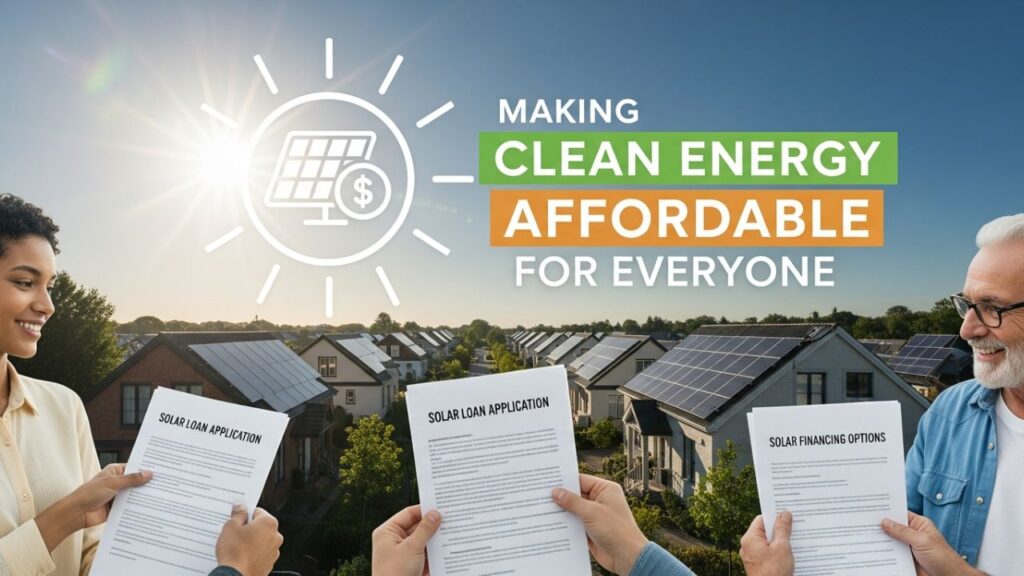Solar power has become one of the most promising and cost-effective sources of renewable energy in the 21st century. Yet, one of the biggest challenges that homeowners and businesses face when switching to solar energy is the initial investment cost. That’s where solar financing and solar loans come in — allowing individuals and companies to adopt solar energy without paying the full cost upfront.
In simple terms, solar financing helps bridge the gap between clean energy aspirations and financial reality. Whether through low-interest solar loans, leasing options, or government-backed schemes, solar financing makes it possible for almost anyone to install solar panels and enjoy long-term energy savings.
In this in-depth guide, we’ll explore how solar financing works, the different types of solar loans, government incentives, eligibility, benefits, and tips to choose the best financing option for your needs.
What Is Solar Financing?
Solar financing refers to the various financial arrangements available to help homeowners, businesses, and organizations install solar power systems without paying the entire cost upfront. These options spread the investment over time, often resulting in monthly payments that are lower than your current electricity bill.
Solar financing ensures that going green doesn’t have to mean going broke. It enables energy independence while offering a sustainable way to reduce long-term electricity costs.
Why Is Solar Financing Important?
The upfront cost of installing a solar system can range from ₹1.5 lakh to ₹10 lakh for residential users (depending on capacity and equipment). While these systems pay for themselves over time through energy savings, not everyone can afford to pay the full amount immediately.

Solar financing:
- Makes solar energy accessible to more households.
- Encourages renewable energy adoption nationwide.
- Allows customers to save money from day one.
- Helps reduce the carbon footprint affordably.
In short, financing is the key to democratizing solar power—making it affordable, practical, and sustainable for everyone.
Read Also: Solar Farm Investment in 2025: A Complete Guide to Profiting from Clean Energy
How Does Solar Financing Work?
Solar financing functions much like other types of loans or leasing programs. You get the solar panels installed, and instead of paying upfront, you repay the cost over time—either through monthly EMIs, lease payments, or power purchase agreements.
Here’s a simple breakdown:
- Choose a Solar Provider: You select a trusted installer or company offering financing options.
- Site Evaluation: Experts assess your property to determine system size and installation feasibility.
- Select a Financing Plan: Options may include loans, leases, or power purchase agreements (PPAs).
- Installation: The system is installed by certified technicians.
- Repayment: You pay the lender or solar company through monthly instalments.
Most importantly, your monthly solar payment often replaces your old electricity bill—meaning you’re simply shifting where your money goes, not spending more overall.
Types of Solar Financing Options
There are several ways to finance a solar energy system, depending on your budget, ownership goals, and long-term plans. Let’s explore the main types:
1. Solar Loans
A solar loan works similarly to a home improvement loan. You borrow money to purchase the solar system outright and then repay it over a set period.
Key Features:
- You own the solar panels from day one.
- You are eligible for government subsidies and tax incentives.
- The system adds value to your property.
- Typical loan tenure: 5 to 15 years.
Pros:
Full ownership of the system
Eligible for subsidies and incentives
Increases home resale value
Savings continue after loan repayment
Cons:
Responsibility for maintenance
Initial credit check required
Example:
If a homeowner installs a ₹4 lakh solar system and gets a loan with a 10-year tenure, their EMI might be ₹4,000–₹5,000 per month. Meanwhile, they could save ₹2,000–₹6,000 monthly on electricity — meaning the system can practically pay for itself.
2. Solar Lease
In a solar lease, a third-party company installs the system at your property, and you pay a fixed monthly lease amount to use the solar energy it generates.
Key Features:
- You do not own the panels.
- Maintenance is handled by the solar provider.
- Lower or zero upfront cost.
Pros:
No maintenance responsibility
Minimal upfront payment
Predictable monthly cost
Cons:
You don’t qualify for subsidies or tax credits
No ownership benefits
Long-term savings may be lower than ownership
Solar leases are ideal for those who want clean energy without worrying about system maintenance or ownership.
3. Power Purchase Agreements (PPA)
In a PPA, you allow a solar company to install panels on your property at no cost. You agree to buy the power generated at a fixed rate, typically lower than the local grid rate.
Key Features:
- No upfront cost for installation.
- Pay only for the electricity consumed.
- The company maintains and operates the system.
Pros:
No investment or maintenance costs
Reduced electricity bills from day one
Long-term rate stability
Cons:
No ownership
No subsidies
Savings depend on energy usage
PPAs are popular for commercial properties and large residential communities looking to cut costs without capital investment.
4. Government-Backed Subsidy Programs
Governments around the world, including India, offer subsidy-based financing to promote renewable energy adoption. Under India’s PM Surya Ghar: Muft Bijli Yojana, homeowners can receive up to 40% subsidy on residential rooftop solar installations.
Features:
- Subsidies directly reduce upfront costs.
- Applicable for residential installations.
- Offered through authorized local DISCOMs.
Example:
For a ₹3 lakh rooftop system, a 40% subsidy means you pay only ₹1.8 lakh. You can finance this remaining amount through a loan, making it even more affordable.
Top Solar Loan Providers in India (2025)
Here are some of the leading banks and financial institutions offering solar financing in India:
| Bank / Institution | Loan Type | Key Features |
| State Bank of India (SBI) | Green Energy Loan | Low-interest loans for rooftop solar systems. |
| HDFC Bank | Home Improvement Loan | Flexible repayment for solar installations. |
| Indian Renewable Energy Development Agency (IREDA) | Solar Project Loan | Special rates for residential and commercial setups. |
| Canara Bank | Solar Rooftop Loan | Supports both grid-connected and off-grid systems. |
| Tata Capital | Solar Financing | Quick approval and minimal documentation. |
Benefits of Solar Loans
Solar loans offer multiple advantages beyond affordability. Let’s break down the key benefits:
1. Full Ownership and Long-Term Savings
Owning the solar panels ensures you enjoy free electricity for 20+ years after repaying your loan.
2. Government Incentives
Loan owners can claim subsidies, tax credits, and depreciation benefits, significantly reducing total costs.
3. Low-Interest Rates
Many banks offer green energy loans at preferential interest rates, making financing more accessible.
4. Positive Environmental Impact
Switching to solar reduces your dependence on fossil fuels, helping combat climate change.
5. Increased Property Value
A home equipped with an owned solar system has higher resale value and faster market appeal.
Eligibility for Solar Financing
While eligibility criteria vary by institution, general requirements include:
- Applicant must be 21 years or older.
- Must have stable income proof (salaried or self-employed).
- CIBIL score above 700 preferred for low-interest loans.
- Property ownership documents.
- Installation quote or proforma invoice from a certified solar vendor.
Documents Required
- ID Proof (Aadhaar / PAN Card)
- Address Proof (Utility Bill, Passport, etc.)
- Income Proof (ITR, Payslip, or Bank Statement)
- Property Ownership Proof
- Vendor quotation or solar project estimate
Steps to Apply for a Solar Loan
- Select Your Solar Vendor: Choose an MNRE-approved installer.
- Get a Quotation: Obtain the system cost and design.
- Contact Your Bank: Apply for a solar loan under their green energy program.
- Submit Documents: Complete the KYC and project paperwork.
- Loan Approval & Disbursement: The bank pays the installer directly or transfers funds to your account.
- Installation & Commissioning: System gets installed, and you start generating clean power.
Solar Financing Example Calculation
Let’s consider a real-world example:
- System Cost: ₹4,00,000
- Loan Tenure: 10 years
- Interest Rate: 9% per annum
- Monthly EMI: ₹5,075
- Monthly Electricity Savings: ₹4,500
👉 Effective monthly cost = ₹575
After 10 years, the system generates free power for the next 15–20 years, saving ₹7–10 lakh in total.
Challenges in Solar Financing
While solar financing has opened doors for millions, certain challenges remain:
- Limited Awareness: Many homeowners are unaware of available loan schemes.
- Credit Dependence: Approval depends on credit history and documentation.
- Policy Differences: Subsidy rules vary by state.
- Long Payback Periods: Some loans have extended tenure before break-even.
With increasing awareness, competition, and policy support, these issues are gradually diminishing.
Future of Solar Financing
The future looks bright — literally. With government incentives, technological innovation, and declining solar prices, solar loans are expected to become as common as home loans.
Trends to watch:
- Digital Solar Loan Platforms: Paperless, instant approvals.
- Peer-to-Peer Solar Investments: Individuals can invest in community solar projects.
- Battery Storage Integration Loans: Finance both solar panels and battery systems together.
- Green Bonds & ESG Funds: Supporting large-scale solar adoption.
As the world moves toward net-zero emissions, solar financing will play a vital role in building a sustainable energy economy.
Read Also: Solar EV Roads: Charging Electric Cars While You Drive
Frequently Asked Questions (FAQs)
1. What is the average payback period for a solar system with a loan?
Typically, 5–8 years depending on system size, tariff rates, and loan interest.
2. Can I get a loan for both solar panels and batteries?
Yes, several banks and NBFCs offer composite solar + battery financing packages.
3. Do I need collateral for a solar loan?
Most residential solar loans are unsecured, though larger systems may require security.
4. What happens if I sell my home with a solar loan?
You can either transfer the loan to the buyer or pay it off during the sale process.
5. Is there a minimum loan amount?
Most banks offer solar loans starting from ₹50,000 and up to ₹15 lakh, depending on the project.
Conclusion
Switching to solar power is no longer a luxury—it’s a smart financial decision and a sustainable lifestyle choice. Thanks to solar financing and loans, clean energy is now within everyone’s reach.
Whether you’re a homeowner aiming to cut utility costs, or a business looking to meet ESG goals, solar financing provides an accessible path to renewable energy independence. With flexible loan terms, government subsidies, and ever-improving technology, the time to go solar is now.
Investing in solar energy today not only powers your home but also secures a cleaner, brighter future for generations to come.
